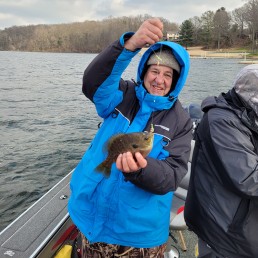Ice-Out Panfishing
SHARE THIS POST
When it comes to ice-out panfishing, it really does not matter when you start as long as you let the sun warm things up just a bit.
The key is warm water: Anyplace where the water is just a few degrees warmer than the rest of the lake is where to start. The northeast corner of the lake is often the warmest due to good sun exposure, all else being equal.
However, if the northeast corner is also the deepest part of the lake, consider another spot. Canals or channels warm up quickly. Most of these locations have a soft or mud bottom. Mud bottoms warm up fast as will a canal or channel.
Locations with decaying vegetation also warm up quicker than the main lake. Decayed vegetation could be junk weeds, pond weeds, reeds or cabbage weeds.
Submerged wood also attracts panfish. Docks, fallen trees, flooded brush and stumps are just a few examples. An old tree lying on the bottom is a sure bet that draws panfish like a magnet.
A culvert that drains into a lake is another source of warm water. Run-off water is generally warmer than the lake and it will wash nutrients into the lake.
Your success will improve when more than one of these items is in the same area. If you spot turtles or muskrats, then you have most likely found a potential hotspot.
Marinas are another location, especially on mid-sized or larger lakes. Look for marinas with wood upright supports. Side scan comes in handy when fishing a marina. Start on the docks receiving the most sun and with the shallower water.
Are you enjoying this post?
You can be among the first to get the latest info on where to go, what to use and how to use it!
The mouths of creeks or rivers are often overlooked. Warmer water flows in and, in most cases, will have a shallow flat with decayed vegetation bordering it. The river or creek creates a wash-out hole where panfish stage before and after leaving shallower water.
The last location is, simply, the top two feet of water. There are days when, for whatever reason, we can’t find the fish in the shallows, but will find pods of fish nearby within two feet of the surface. Sometimes, these pods can even be found in the middle of the lake! Other times, these schools will be located very near the surface, hanging out close to a drop-off that is adjacent to a warm, shallow-water location.
While Livescope is the rage, side scan is a much better search tool in the shallows. Just about any graph sold today offers side scan. Please, watch a few videos on how to use side scan. It is a tremendous scouting tool.
Set your range between 60 and 80 feet. This will cover a swath 120 to 160 feet wide. When we follow a shoreline, we set the range to 100 feet and only to show the shoreline side. With side scan, you can cruise along at speeds up to 5 mph.
Regardless of the technique that you pick, fishing the warmest water will land you the most fish.
You’ll find plenty of helpful spring fishing tips in the spring issues of MidWest Outdoors. Subscribe on our website.
MWO
SHARE THIS POST
You may also like...
Nothing found.
Did you enjoy this post?
You can be among the first to get the latest info on where to go, what to use and how to use it!
Jack Payne
Jack Payne is an accomplished angler and hunter who enjoys teaching others as much as learning from others. Seminar speaker, outdoor photography enthusiast, hunter safety instructor and volunteer at many events for both kids and adults as an instructor.
